
A doghouse, also known as a kennel, is an outbuilding to provide shelter for a dog from various weather conditions. [1]

A doghouse, also known as a kennel, is an outbuilding to provide shelter for a dog from various weather conditions. [1]

Humans and domesticated dogs have been companions for more than 15,000 years, beginning with the wolf and hunter–gatherers. [2] Initially, dogs would inhabit the outdoors staying close to humans. [3] Mud was used to construct the earliest known doghouses. [4] [3] Over the millennia crude doghouses were built from the scrap material that was available to owners at the particular time and place. [3]
During the Industrial Revolution and economies of scale allowed manufactured doghouses to become a commodity that could be sold to the mass market. [5] Mass production allowed manufacturers to improve the design and quality of materials used to construct a doghouse.
During the 1800s, the animal rights movement began creating legislation for animal rights and animal welfare. [6] This allowed the creation of organizations like the humane society and the Society for the Prevention of Cruelty to Animals (SPCA), which have set standards of care for dogs that live outdoors including a properly designed doghouse that is structurally sound, weatherproof, insulated, of adequate size and appropriate for the dog's use, at all times. [7] Municipalities enforce legislation to protect dogs living outdoors with the animal control service. [8]
A wide variety of materials are used to make doghouses, including: hardboard, hard wood, plywood, and plastic. Do it yourself (DIY) projects allow owners to construct the doghouse to their exact design specifications using the best possible materials for their dogs' needs. [9]
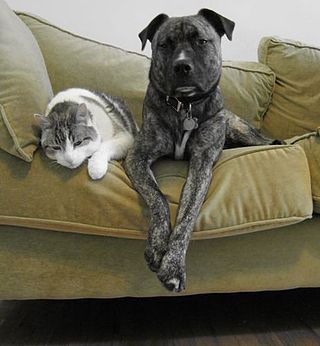
A pet, or companion animal, is an animal kept primarily for a person's company or entertainment rather than as a working animal, livestock, or a laboratory animal. Popular pets are often considered to have attractive/cute appearances, intelligence, and relatable personalities, but some pets may be taken in on an altruistic basis and accepted by the owner regardless of these characteristics.
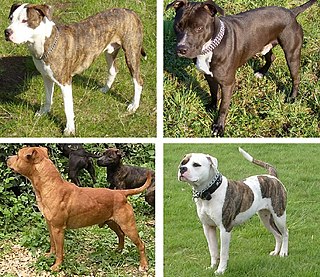
Pit bull is an umbrella term for several types of dog believed to have descended from bull and terriers. In the United States, the term is usually considered to include the American Pit Bull Terrier, American Staffordshire Terrier, American Bully, Staffordshire Bull Terrier, and sometimes the American Bulldog, along with any crossbred dog that shares certain physical characteristics with these breeds. In other countries, including the United Kingdom, the term is used as an abbreviation of the American Pit Bull Terrier breed specifically, while the Staffordshire Bull Terrier is not considered a pit bull. Most pit bull-type dogs descend from the British bull and terrier, a 19th-century dog-fighting type developed from crosses between the Old English Bulldog and the Old English Terrier.

An animal shelter or pound is a place where stray, lost, abandoned or surrendered animals – mostly dogs and cats – are housed. The word "pound" has its origins in the animal pounds of agricultural communities, where stray livestock would be penned or impounded until they were claimed by their owners.
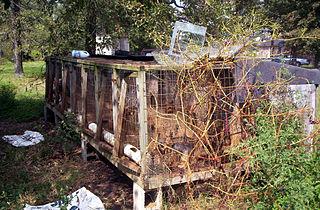
A puppy mill, also known as a puppy farm, is a commercial dog breeding facility characterized by quick breeding and poor conditions. Although no standardized legal definition for "puppy mill" exists, a definition was established in Avenson v. Zegart in 1984 as "a dog breeding operation in which the health of the mill’s dogs is disregarded to maintain a low overhead and maximize profits". They are cited as being a result of increased demand for household pets, especially after World War II. The Veterinary Medical Association of the Humane Society of the United States defines the main characteristics of a puppy mill as "emphasis on quantity over quality, indiscriminate breeding, continuous confinement, lack of human contact and environmental enrichment, poor husbandry, and minimal to no veterinary care."
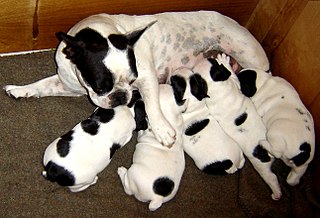
Dog breeding is the practice of mating selected dogs with the intention of maintaining or producing specific qualities and characteristics. When dogs reproduce without such human intervention, their offspring's characteristics are determined by natural selection, while "dog breeding" refers specifically to the artificial selection of dogs, in which dogs are intentionally bred by their owners. Breeding relies on the science of genetics, hence a breeder who is knowledgeable on canine genetics, health, and the intended purpose of the dogs attempts to breed suitable dogs.

A working dog is a dog used to perform practical tasks, as opposed to pet or companion dogs.

A herding dog, also known as a stock dog or working dog, is a type of dog that either has been trained in herding livestock or belongs to one of the breeds that were developed for herding. A dog specifically trained to herd sheep is known as a sheep dog or shepherd dog.
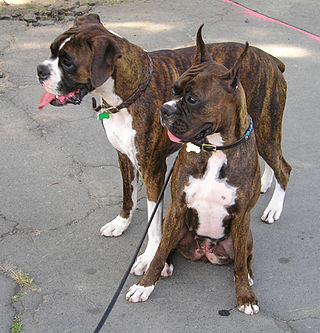
Docking is the removal of portions of an animal's tail. While docking and bobbing are more commonly used to refer to removal of the tail, the term cropping is used in reference to the ears. Tail docking occurs in one of two ways. The first involves constricting the blood supply to the tail with a rubber ligature for a few days until the tail falls off. The second involves the severance of the tail with surgical scissors or a scalpel. The length to which tails are docked varies by breed, and is often specified in the breed standard.

In law, breed-specific legislation (BSL) is a type of law that prohibits or restricts particular breeds or types of dog. Such laws range from outright bans on the possession of these dogs, to restrictions and conditions on ownership, and often establishes a legal presumption that such dogs are dangerous or vicious to prevent dog attacks. Some jurisdictions have enacted breed-specific legislation in response to a number of fatalities or maulings involving pit bull–type dogs or other dog breeds commonly used in dog fighting, and some government organizations such as the United States Army and Marine Corps have taken administrative action as well. Due to opposition to such laws in the United States, anti-BSL laws have been passed in 21 of the 50 state-level governments, prohibiting or restricting the ability of jurisdictions within those states to enact or enforce breed-specific legislation.

A kennel is a structure or shelter for dogs. Used in the plural, the kennels, the term means any building, collection of buildings or a property in which dogs are housed, maintained, and bred. A kennel can be made out of various materials, the most popular being wood and canvas. The term "kennel" can also refer to a dog crate or doghouse.
A dog collar is a piece of material put around the neck of a dog. A collar may be used for restraint, identification, fashion, protection, or training. Identification tags and medical information are often placed on dog collars. Collars are often used in conjunction with a leash for restraining a dog. Collars can be traumatic to the trachea if the dog pulls against the restraint of the leash, causing severe pressure to the neck. Use of a harness instead of a collar may be beneficial for dogs prone to tracheitis or those with a collapsed trachea. Conversely, dog breeds with slender necks or smaller heads may easily slip out of collars that are too loose. This can be avoided by using a martingale dog collar which tightens to distribute pressure around the neck when training the dog not to pull. Any style of dog collar must be properly fitted to ensure safety and collars should not be worn when the dog is unattended.
In some countries there is an overpopulation of pets such as cats, dogs, and exotic animals. In the United States, six to eight million animals are brought to shelters each year, of which an estimated three to four million are subsequently euthanized, including 2.7 million considered healthy and adoptable. Euthanasia numbers have declined since the 1970s, when U.S. shelters euthanized an estimated 12 to 20 million animals. Most humane societies, animal shelters and rescue groups urge animal caregivers to have their animals spayed or neutered to prevent the births of unwanted and accidental litters that could contribute to this dynamic.

The Finnish Lapphund is a hardy, easy going, medium-size breed of Spitz type. Traditionally it has been used for herding reindeer. Although it is one of the most popular dog breeds in its native country, Finland, it is not very numerous outside of the Nordic countries.

The Royal New Zealand Society for the Prevention of Cruelty to Animals is a New Zealand charitable society who work to promote the humane treatment of animals. The society consists of 30 animal shelters and 6 vet partnerships around New Zealand, including many in regional areas. Under the Animal Welfare Act 1999, SPCA inspectors have the exclusive power to investigate animal welfare complaints and prosecute abusers when necessary. The Royal NZ SPCA has initiated a range of animal welfare campaigns. It has launched public education campaigns about the humane treatment of animals, and has encouraged people to change their behaviour towards animals. SPCA has also run advocacy campaigns aimed at promoting law changes or questioning the legality of certain practices.
A no-kill shelter is an animal shelter that does not kill healthy or treatable animals based on time limits or capacity, reserving euthanasia for terminally ill animals, animals suffering poor quality of life, or those considered dangerous to public safety. A no-kill shelter uses many strategies to promote shelter animals; to expanding its resources using volunteers, housing and medical protocols; and to work actively to lower the number of homeless animals entering the shelter system. Up to ten percent of animals could be killed in a no-kill shelter and still be considered a no-kill shelter.
The National Animal Interest Alliance (NAIA) is a non-profit organization in the United States dedicated to promoting animal welfare and animal husbandry practices, strengthening the human-animal bond, and safeguarding the rights of responsible animal owners and professionals through research, public education and public policy. The NAIA mission is "to promote the welfare of animals."
The Dublin Society for Prevention of Cruelty to Animals or DSPCA is a registered charity, established in 1840 to prevent cruelty to animals in Dublin in Ireland.
Brian Davies was a Welsh animal welfare activist who founded three major international animal welfare organizations, Network for Animals (NFA), Animal Survival International (ASI) and the International Fund for Animal Welfare (IFAW). Davies retired from the IFAW in 2003, but remained active at the NFA and ASI.
Alanna Devine is a Canadian lawyer who practices animal law in Quebec and Ontario. She completed her undergraduate degree in criminology at the University of Toronto and obtained degrees in civil and common law at McGill University Faculty of Law in Montreal, before clerking for the Honorable Justice Louise Charron at the Supreme Court of Canada. While a student she founded the McGill Student Animal Legal Defense Fund, a chapter of the Animal Legal Defense Fund. She has been a member of the Law Society of Ontario since 2007.
Dogs in the United States have significant popularity and status – they are often treated as family members. Currently, the American Kennel Club is the largest registry of pure breed dogs across the world.